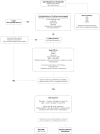Diagnosis and Treatment of Central Nervous System Infections in the Emergency Department
- PMID: 27741995
- PMCID: PMC5082707
- DOI: 10.1016/j.emc.2016.06.013
Diagnosis and Treatment of Central Nervous System Infections in the Emergency Department
Erratum in
-
Erratum.Emerg Med Clin North Am. 2017 May;35(2):xix. doi: 10.1016/j.emc.2017.02.001. Emerg Med Clin North Am. 2017. PMID: 28411939 No abstract available.
Abstract
Central nervous system (CNS) infections, including meningitis, encephalitis, and brain abscess, are rare but time-sensitive emergency department (ED) diagnoses. Patients with CNS infection can present to the ED with nonspecific signs and symptoms, including headache, fever, altered mental status, and behavioral changes. Neuroimaging and CSF fluid analysis can appear benign early in the course of disease. Delaying therapy negatively impacts outcomes, particularly with bacterial meningitis and herpes simplex virus encephalitis. Therefore, diagnosis of CNS infection requires vigilance and a high index of suspicion based on the history and physical examination, which must be confirmed with appropriate imaging and laboratory evaluation.
Keywords: Brain abscess; Diagnosis; Emergency department; Encephalitis; Meningitis; Treatment.
Copyright © 2016 Elsevier Inc. All rights reserved.
Conflict of interest statement
M.D. and S.Y.L. report no conflicts of interest in this work.
Figures


References
-
- Tintinalli JE, Stapczynski JS. Tintinalli’s emergency medicine: a comprehensive study guide. 7th. New York: McGraw-Hill; 2011.
-
- Fitch MT, Abrahamian FM, Moran GJ, et al. Emergency Department Management of Meningitis and Encephalitis. Infect Dis Clin North Am. 2008;22(1):33–52. - PubMed
-
- Gottfredsson M, Perfect JR. Fungal meningitis. Semin Neurol. 2000;20(3):307–22. - PubMed
-
- Smith RM, Schaefer MK, Kainer MA, et al. Fungal infections associated with contaminated methylprednisolone injections. N Engl J Med. 2013;369(17):1598–609. - PubMed
Publication types
MeSH terms
Grants and funding
LinkOut - more resources
Full Text Sources
Other Literature Sources

